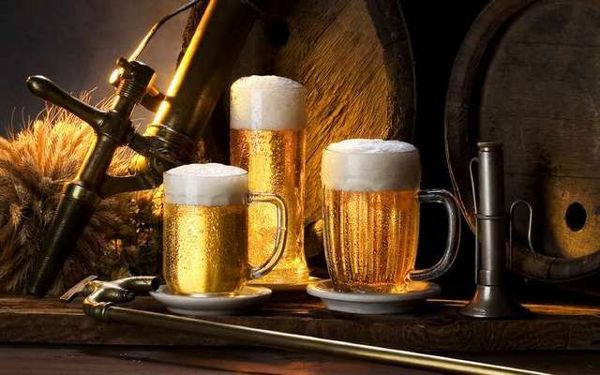Beer quality evaluation is considered both an art and a science. Majority of the people judge beer while they drink, whether they realize it or not. Evaluation is a skill which anyone can learn, with continuous practice and a bit of knowledge about the terminologies and descriptors.

Beer has existed since ancient times so has beer evaluation and tasting. In the modern days, the techniques behind beer evaluation using the senses have become very advanced that it can even fill a whole book.
But we have compressed this supposed-to-be one book in just a few pages in this article. If you are interested in how you can use your senses to evaluate beers just like a pro, keep on reading!
#1 Sight
Although your sense of sight is indispensable in your daily life, it’s importance is not comparable to that of a beer’s evaluation.
The appearance of a beer includes its:
- Fill level,
- Amount of sediment,
- Color,
- Head’s texture,
- Head size,
- Retention, and
- Clarity.
For most of the part, anyone can accurately evaluate these. Finding one who is equitably subjective is hard.
The color of a beer can be affected by the background and the light in which the beer is viewed. Try evaluating beer in decent light sources like fluorescent lights and sunlight. These contain a substantial wavelength proportion of light that the eye is able to see. Also, try using a white background (can be a piece of paper) for the color evaluation of a beer.
Using a red background will make a beer of amber color appear deeper. Other background colors, such as green, will absorb all of the beer’s red hues.
#2 Taste
Many believe that what they taste in beer also represents its flavor. But actually, the flavor of a beer is controlled by its:
- Appearance,
- Taste,
- Smell, and
- Mouthfeel.
Not only these, but even the beer’s effects on your memories also influence its flavor.
Recent studies have shown that there are six fundamental flavors perceivable by humans. These flavors have developed by means of evolution to assist us in determining which foods are poisonous and which ones are nutritious. The six fundamental flavors are:
- Sweet
- Sour
- Salty
- Bitter,
- Umami (a Japanese word for deliciousness), and
- Fatty.
You can check this link for a list of other beer flavors and descriptions.
You would only need as little as one tablespoon per sip of beer in order to evaluate a its taste. Try swishing the beer all around so that it will contact all of your tongue’s parts and your mouth’s palate. After which swallow the beer to complete your evaluation.
During your first sip, record the beer’s character. On the second, take note of the beer’s bitter, salty, sour, and sweet qualities based on how these transpire to you. With the third sip, record the beer’s mouthfeel. And on the fourth sip, look for the qualities of the beer’s aftertaste.
The flavor of a beer is affected by all of the other aspects such as appearance, smell, and mouthfeel. It is important in beer evaluation to know that even when only one of your senses is off, other senses will be affected as well.
For brewers, it should be noted the beer’s taste is also affected by the materials and equipment used in the beer brewing process. Materials made from hygienic stainless steels are required for food and beverage industries especially if these come into direct contact with the product. Metal materials are prone to corrosion and the corroded materials will get mixed with the product causing a metallic taste.
Of course, the brewing containers are made of stainless steel but make sure that valves are as well. Industrial products from XHVAL, a ball valve China manufacturer, would be suitable for applications dealing with corrosive substances such as beer.
#3 Smell
The beer’s bouquet and aroma are surely the foremost things that you will notice when you unconsciously evaluate a beer. The smell lasts momentarily once you open a beer so make sure this is the first thing you evaluate. The aroma does not stay constant and will change over time with temperature. Quickly evaluating a beer’s aroma is a must.
The aroma of a beer is a vital part of its enjoyment. Furthermore, it is integral to its taste. You would know what I mean if you have tried eating something while having a cold. Aside from the high levels of contaminants and chemicals, the beer’s aroma might also cause emotional responses during the beer evaluation.
To make the aroma of the beer reach your nasal passage’s “detectors,” you can either:
- Take a single deep sniff but make sure it is a long one, or
- Take several short sniffs.
Scrutinize the beer’s aroma momentarily. Take note of the aromas obtained from the beer ingredients and fermentation’s natural smell. Locate odors that don’t seem to belong and identify them.
*Check this article if you want to know more about the beer fermentation process.
#4 Tactile
The sense of feel or touch, also known as tactile sense, is distinguished in the mouthfeel of a beer’s body and the temperature during beer evaluation. The texture of the beer is sensed and perceived as being:
- Dry,
- Thick,
- Thin
- Oily
- Silky
- Warm, and
- Menthol-like or cooling.
The harshness of a beer can also be sensed as it is being manifested as a puckering sensation.
Mouthfeel is a very important aspect of the beer evaluation. Many people even go a long way to manipulate these towards their liking.
#5 Pleasure
The final factor is the general impression given by the beer. These are the questions you should be asking yourself:
- How much pleasure did the beer give to me?
- Do I want to drink another beer similar to it?
- Can I drink more than a pint?
- Will I seek for it and am I willing to pay money just to drink the beer again?
Consider the importance of pleasure in beer evaluation. Because the overall impression of the beer that you take with you in every beer evaluation is what you are left with for the succeeding days or years.
Conclusion
Whether you’re just a beer enthusiast or a brewer, the art and science of beer evaluation are quite fascinating. Learning these techniques will be useful especially to the brewers. This is because being able to describe a good beer is essential before they can refine their ingredients or processes. All of this help improve the beer’s aroma, flavor, or mouthfeel.




Recent Comments